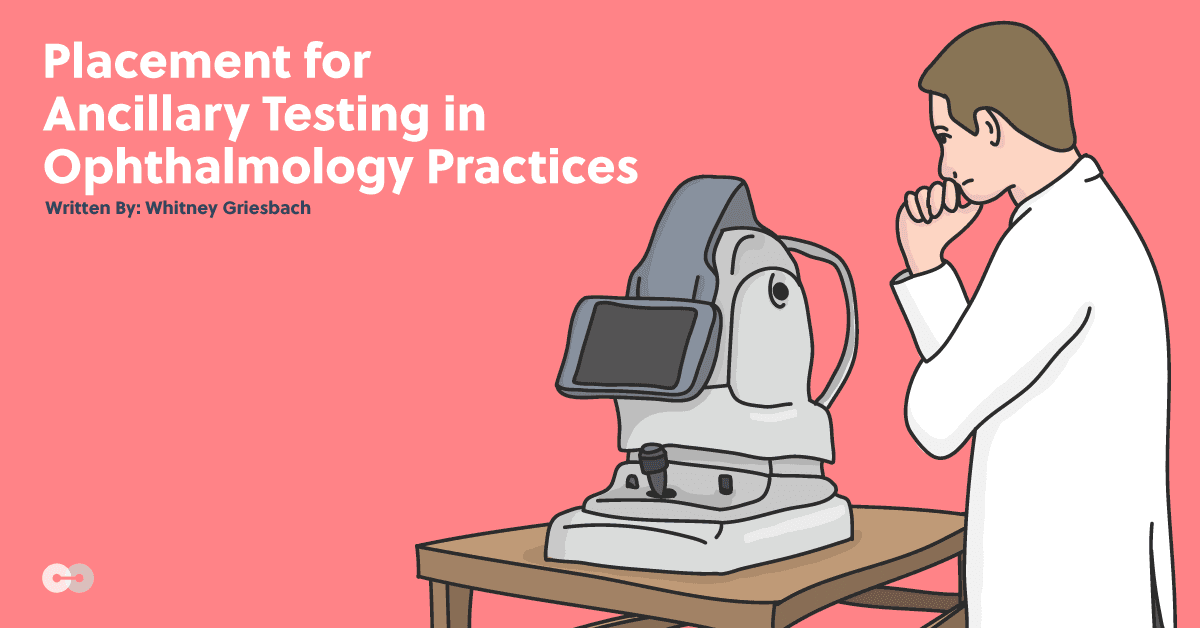In the extraordinary world of ophthalmology and optometry, ancillary testing is a crucial part of the patient diagnosis.
Examples of ancillary testing include:
- Visual field examination
- OCT (Optical Coherence Tomography)
- Biometrics (retinal scans, iris scans, etc.)
By setting up an eye services unit with the correct placement of the ancillary equipment, an office or healthcare organization is preparing for ultimate success.
Strategic placement for patient flow
The ophthalmology division of one hospital and academic medical center in the Greater Boston area has strategically placed the OPTOS machine right by the front desk of the clinic where patients can easily complete the test before entering the next stage of the visit, deeper into the clinic. This machine is also utilized to work with the hospital’s Primary Care Division to capture care gaps for patients needing a diabetic retina exam (photo) annually. By placing the OPTOS close to the front desk, the primary care patients can be walked over right away near the entrance allowing for a quick in and out experience. Placing the equipment in key lean areas allows for a shorter process and less wait time.
The OPTOS is a device for retinal imaging, enabling eye care professionals to diagnose and document to treat ocular pathology. Optos high-resolution imaging devices can image eighty percent of the retina in one simple picture. It’s quite amazing! The ancillary test, once completed right away, then lets the provider decide quickly on whether or not the patient needs further testing or treatment.
Placing ancillary equipment to mimic and capture the flow of the patients’ footsteps in the direction from start to finish is a wise way to keep the flow going and prevent any bottlenecks. Having more than one machine helps to fight the frustrations as well with bottlenecks.
Consider patient volume—and your techs’ needs
At the same division in Boston, there were over 80-100 OCTs completed in one day for only a few of the providers. The OCT testing can take anywhere from five to ten minutes, depending on the type of OCT and the mobility of the patient. A patient may have a walker with them, or they could have trouble moving their head to the machine.
Patients with optic neuritis may especially have trouble moving their heads along with the OCT machine, due to pain.
Remember, not all patients are able to move as quickly as others, which is why we need to remember that we walk the patient to the testing room side by side (not ahead), while also ensuring the testing room isn’t that far away. Again, the environment and placement of the testing areas are key to providing a better patient experience.
The team needed to invest in a second Heidelberg machine to help route the retina OCTs from the general/neuro and optometry OCTs in order to have a smoother flow. Both patients and the team, especially the techs, were appreciative of this move.
Not all are able to allow funds for a second machine, but it truly makes a difference in the flow.
Lastly, to really optimize the flow of a clinic and ancillary testing, there should be testing rooms allotted for one to two machines only. Remember, considering patient confidentiality and HIPAA laws to keep information private is very important. Not only do you want to keep patient information private, but you also want to be able to move around easily and consider patients who are coming in by stretcher or wheelchair.
Placing ancillary testing for better patient experience
By moving your ophthalmology testing equipment to adjust to the patient flow in the clinic, you will create an experience that makes sense to the patient. The goal, of course, is also to address any inefficiencies that don't make sense—to your staff or the patient.
Say your testing equipment is in the far back of the unit when it’s one of the first steps into a workup before the optometrist or ophthalmologist meets with the patient. You would want to move this as close to the check-in desk as possible, so the patient doesn't have to walk as far and each step is aligned with the direction of patient flow. Whether your space looks like a circle or a rectangle, you want to ensure each station and step in the timestamp of the patient visit makes sense and has its own purpose for the next step.
When making such improvements to office efficiency, you also improve the patient experience, as this work ultimately decreases wait times.
It is imperative that the patient is updated during their visit about their own individual wait times so they can continue to know what to expect. Even if the wait time is severely long, the update will allow the patient to get a coffee, run an errand, etc., before being seen.
Collaborate with other ophthalmologists to improve your office!
There are many ways to utilize space for ancillary testing. Sometimes all it takes is a visit to other eye centers to partner, brainstorm, understand and think critically about how your space can be used to its most efficient potential! By visiting other practices and healthcare organizations you can learn from others’ inefficiencies as well as help to make improvements together.
You may also understand struggles that even you—yes YOU—can offer suggestions to address with an “outside eye” perspective. Learning the facility, their selected EHR, equipment, staffing, faculty size, patient volume/visits, and space capacity, will ensure you are taking the steps needed to provide a better patient experience.
